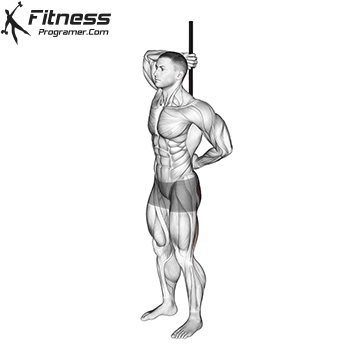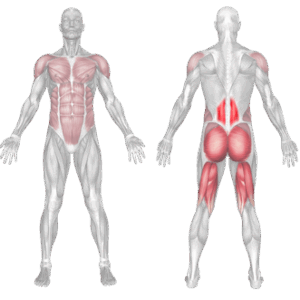Overview
The PVC hip hinge is a form and mobility exercise that helps individuals understand the correct way to hinge at the hips while keeping the spine neutral. It involves holding a PVC pipe along the spine to give tactile feedback and ensure the head, upper back, and tailbone remain in alignment throughout the movement. This drill is essential for mastering movements like deadlifts, RDLs, and kettlebell swings, and helps prevent injury by improving awareness of posture and control.
How to Perform PVC Hip Hinge

Stand with feet hip-width apart, knees slightly bent.
Hold a PVC pipe vertically along your spine, using one hand behind your neck and the other behind your lower back.
Ensure three contact points: the back of the head, between the shoulder blades, and the tailbone.
Begin the hinge by pushing your hips back, keeping your spine straight and the PVC in contact with all three points.
Lower your torso until you feel a stretch in your hamstrings, then return to the starting position by driving your hips forward.
Tips for Proper Form
Maintain all three contact points on the PVC throughout the movement.
Bend only at the hips, not at the waist or spine.
Keep your chest up and shoulders back as you hinge.
Shift your weight into your heels, not your toes.
Move slowly and with control to reinforce proper technique.
Common Mistakes
Losing contact with the PVC at the lower back or head.
Bending the spine, rather than hinging at the hips.
Allowing the knees to bend excessively, turning the hinge into a squat.
Pushing the hips downward instead of backward.
Rushing the movement, which reduces the effectiveness of the drill.
Benefits of the PVC Hip Hinge
Teaches Proper Lifting Mechanics: Helps build the foundation for exercises like deadlifts, good mornings, and kettlebell swings.
Improves Postural Awareness: Reinforces spinal alignment and body control using tactile feedback.
Enhances Hip Mobility: Encourages movement through the hips while maintaining a neutral spine.
Reduces Injury Risk: Trains safe movement patterns that protect the lower back during loaded exercises.
Activates the Posterior Chain: Engages the glutes and hamstrings, preparing them for strength training.
Perfect for All Levels: Suitable for beginners, rehab clients, or advanced athletes refining technique.
Effective in Warm-Ups and Drills: Ideal before training sessions to reinforce movement patterns and prep the hips.
How to Incorporate Into Your Routine
- For Beginners: Perform 2–3 sets of 8–10 slow, controlled reps before strength training.
- For Technique Practice: Use between sets of deadlifts or RDLs to reinforce hinge form.
- For Strength Training Prep: Add to your warm-up to activate the posterior chain and improve alignment.
- For General Fitness: Include 2–3 times per week to improve hip movement awareness.
- For Rehab or Posture Work: Use light resistance or bodyweight-only for corrective exercise routines.
PVC Hip Hinge: Muscles Worked

Frequently Asked Questions
Why use a PVC pipe for the hinge?
It provides feedback for correct spine alignment and helps identify breakdowns in form.
Is this exercise good for beginners?
Yes. It’s one of the best drills for teaching proper movement mechanics from the start.
Can I use a broomstick instead?
Absolutely. Any straight, light dowel can serve the same purpose.
How do I know if I’m doing it right?
Maintain contact at your head, back, and tailbone with the pipe. If one lifts off, adjust your hinge.
Should I feel it in my back?
No. You should feel a stretch in the hamstrings and engagement in the glutes, not strain in the spine.
